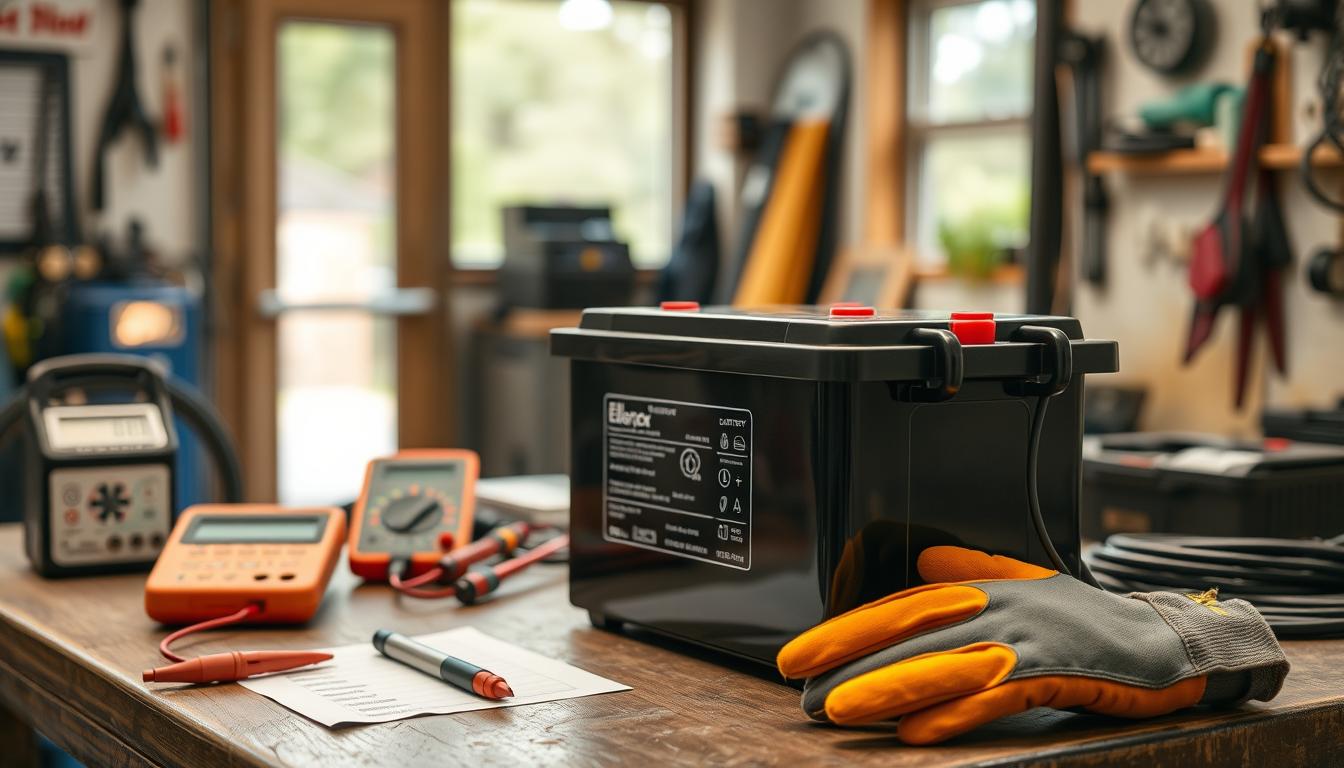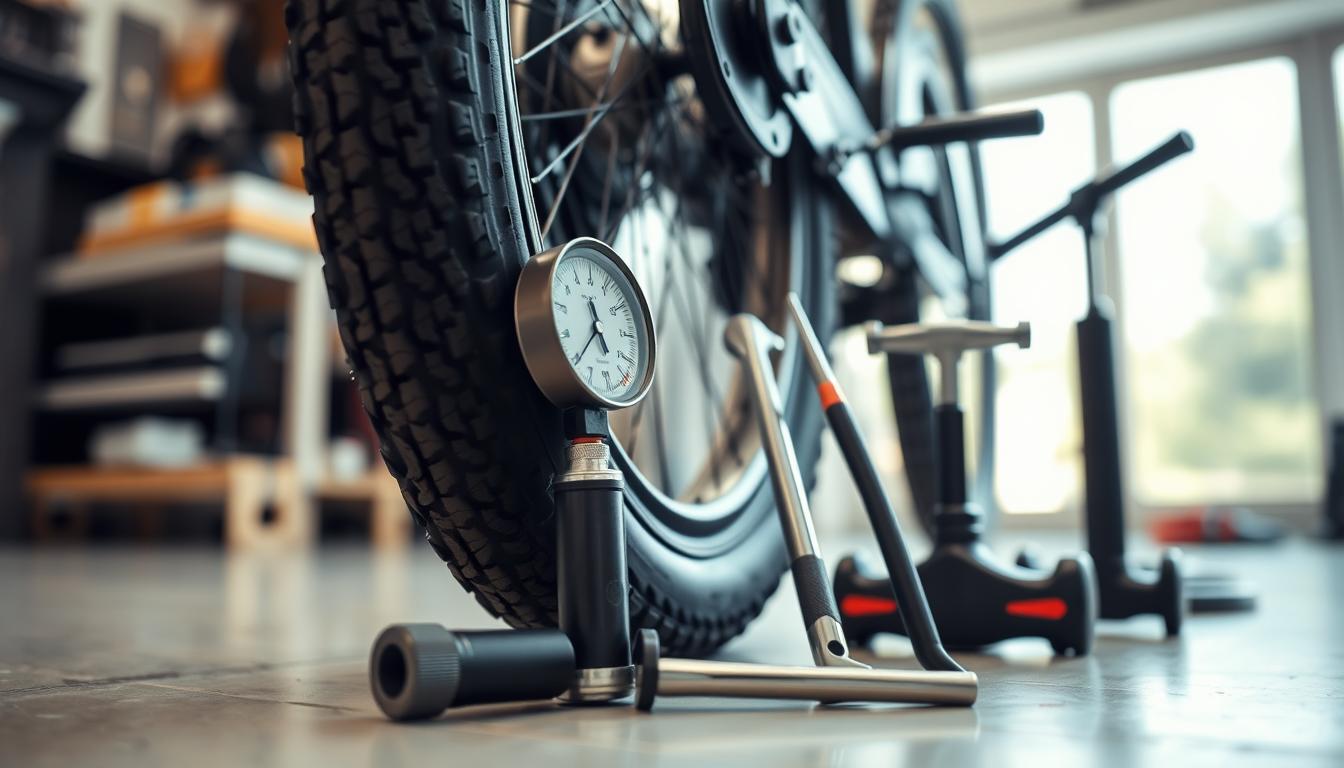Did you know electric bike batteries can lose up to 5% of their charge yearly? This shows how important it is to take good care of your e-bike.
As someone who loves e-bikes, I’ve found that maintenance is key. It’s not just about looks; it’s about keeping your bike running well. Regular care can make your bike last longer and work better.
Learning about electric bike maintenance is easy. With the right tips, you can keep your e-bike in great shape. This guide will cover everything from cleaning to special care tips.
Whether you’re new to e-bikes or have been riding for years, knowing how to maintain your bike is essential. It helps your bike perform better, avoids sudden problems, and saves you money on repairs. Let’s explore the best ways to keep your electric bike in shape.
Understanding Your Electric Bike Components
Electric bikes combine old-school cycling with new tech. Knowing the key parts is key to top performance and a smooth ride. Modern e-bikes have many systems that work together. Let’s look at the main parts that make your e-bike work well.
E-Bike Motor System Overview
The motor system is the heart of your electric bike.
There are different motors for different rides:
- Rear hub motors give excellent traction and control.
- Front hub motors are more affordable.
- Mid-drive motors balance weight well.
Battery Components
Battery technology is vital for electric bike performance. Understanding battery parts helps them last longer and work better.
Electric Bike Components:
| Battery Characteristic | Recommended Practice |
| Voltage Range | 38-52 Volts. |
| Optimal Charge Level | 20-80% For maximum lifespan. |
| Storage Condition | Cool, dry place at 50% charge. |
Electronic Controls and Display
The e-bike’s electronic interface gives you essential info and control.
Modern LCD Displays show:
- Real-time speed tracking.
- Battery charge level.
- Remaining travel range.
- Pedal-assist mode selection.
A remarkable quote for e-bikers,
Understanding your E-Bike’s components is the first step to becoming a confident and responsible electric bike owner.
Knowing your e-bike’s parts will prepare you to keep it in shape. Then, you can enjoy a reliable, high-performance ride.
Basic Electric Bike Maintenance Schedule
A good e-bike maintenance schedule is key to keeping your electric bike in shape. While taking care of your e-bike is simple, it requires regular effort.
Timing is key when it comes to e-bike maintenance.
Here’s a detailed look at when to do essential maintenance tasks:
- Daily Checks: Quick pre-ride inspection:
- Tire pressure verification.
- Battery charge level.
- Brake system functionality.
- Weekly Maintenance: Detailed inspection:
- Chain lubrication.
- Electrical connection checks.
- Loose component verification.
- Monthly Deep Clean: Thorough service:
- Thorough bike cleaning.
- Drivetrain inspection.
- Suspension assessment.
I suggest a basic tune-up every 3 to 4 months or after 1,000 miles. This will keep your e-bike running smoothly and avoid expensive repairs.
Consistent maintenance prevents unexpected breakdowns and extends your e-bike’s lifespan.
Regular maintenance is vital. Checking tire pressure, lubricating the chain, and checking electrical connections can save you time and money. Spending a few minutes weekly on your e-bike’s care means smoother rides and a better investment.
Proper Cleaning Techniques for E-Bikes
Keeping your electric bike clean is key to its performance and longevity. E-Bike cleaning requires special care to protect its electrical parts and ensure its well-being.
Cleaning an electric bike is different from washing a regular bike. You must be careful with the electrical systems to avoid damage.
Safe Washing Methods for Electric Bike Maintenance
Here are essential steps for washing your electric bike:
- Turn off the e-bike system before cleaning.
- Remove the battery if possible.
- Use low-pressure water sources.
- Avoid direct water streams on electrical components.
Recommended Cleaning Tools and Approach
Use special tools for cleaning your e-bike to keep it in good shape:
- Soft-bristled brushes.
- Bicycle-specific cleaning solutions.
- Microfiber cloths.
- Degreaser for chain and drivetrain.
Electrical Component Care
It’s vital to protect your e-bike’s electrical parts during cleaning. Bosch suggests covering controllers and being careful around sensitive areas.
Treat your E-Bike’s electrical components with the same care you’d give sophisticated electronics.
Proper Cleaning Techniques for E-Bikes:
| Cleaning Aspect | Recommended Action | Potential Risk if Ignored |
| Battery Area | A gentle wipe with a dry cloth | Moisture-related corrosion. |
| Electrical Connections | Use compressed air | Short circuit risk. |
| Motor Housing | Soft brush, minimal moisture | Seal damage. |
Post-Cleaning Care
After cleaning, make sure your e-bike is completely dry. Then, apply a light protective spray to metal parts. This can cut rust by up to 30% and protect your e-bike’s essential parts. Remember, cleaning your e-bike right isn’t just about looks. It’s about keeping it running well and lasting longer.
Battery Care and Charging Best Practices
E-Bike Battery Maintenance Guide
Keeping your e-bike battery in good shape is key to long-lasting performance. Charging is not just about doing so; it’s a careful process that can extend the battery’s life. Knowing how to charge your electric bike is essential. Most e-bike batteries are lithium-ion and need special care to work at their best.
Here are some tips to keep your battery in great shape:
- Charge at room temperature (ideally around 68°F/20°C).
- Avoid complete discharge or full charge for extended periods.
- Maintain battery charge between 20-80% for optimal longevity.
- Use only the manufacturer-provided charger.
Electric vehicle expert Michael Thompson says,
Proper battery care can double your E-Bike battery’s lifecycle.
It’s essential to store your battery correctly. Keep it at about 50% charge in a cool, dry place. High temperatures over 105°F can damage your battery, and cold temperatures can make it less efficient.
Here’s a quick guide for charging your battery:
| Practice | Recommendation |
| Charging Frequency | After every ride or when the battery drops to 20%. |
| Charging Time | 3-4 Hours typical. |
| Storage Charge Level | 50% Charge. |
You’ll get the most out of your battery by following these tips, making it last longer and ensuring reliable rides for years.
Drivetrain Maintenance and Lubrication
Keeping your e-bike’s drivetrain in top shape is key for a long-lasting ride. Electric bike chains need extra care because they handle more stress and power.
Effective maintenance of your e-bike’s drivetrain is essential. It ensures your bike runs smoothly and efficiently. I’ll show you the critical steps to protect your investment and keep your bike performing at its best.
Chain Care Guidelines
Proper chain lubrication is vital for drivetrain health. Regular care can extend the life of your chain by 40-50%.
Here’s how to do it right:
- Clean the chain well before adding lubricant.
- Use special e-bike chain lubricants.
- Spread lubricant evenly over the whole chain.
- Remove any extra lubricant to avoid dirt buildup.
Gear System Maintenance
Your e-bike’s gear system needs regular checks. Experts suggest detailed tune-ups twice a year to avoid problems.
Drivetrain Maintenance and Lubrication:
| Maintenance Task | Frequency | Benefits |
| Chain Lubrication | Every 100-150 miles | Reduces noise by up to 50%. |
| Gear Alignment Check | Quarterly | Prevents early wear. |
| Comprehensive Drivetrain Inspection | Bi-annually | Increases component life. |
Lubrication Schedule
Having a regular lubrication plan is essential for e-bike maintenance. I suggest lubricating your chain every few weeks. Do this more often if you ride in dusty or wet areas.
A well-lubricated chain is the secret to a smooth and efficient E-Bike ride.
These tips boost your e-bike’s performance, reduce maintenance costs, and ensure a more reliable ride.
Tire Care and Pressure Management
Keeping your e-bike tires in top shape is key for a great ride. As someone who rides a lot, I’ve found that caring for your tires is more than just filling them up. It’s about knowing what your electric bike needs.
E-Bike Tire Maintenance Guide
Getting the correct electric bike tire pressure is vital for a smooth ride. Studies show that the proper pressure can make your bike go faster and use less battery by about 15%.
Here’s how to manage your e-bike tire pressure:
- Check tire pressure weekly.
- Use a reliable floor pump with an accurate gauge.
- Adjust pressure based on rider weight and terrain.
- Inspect tires before and after rides.
The pressure you need depends on your e-bike. Fat tire e-bikes need 5-30 PSI, while road bikes need 70-120 PSI. Also, cold weather can change tire pressure, so always check.
Proper tire maintenance is the secret to a smooth and safe electric bike ride.
Tire Care and Pressure Management:
| Tire Type | Recommended PSI Range | Frequency of Check |
| Fat Tire E-Bikes | 5-30 PSI | Weekly |
| Road/Hybrid E-Bikes | 70-120 PSI | Weekly |
| Racing Tires | 100-145 PSI | Before Each Ride |
E-Bike tires wear out faster because of their extra weight and power. If the pressure is off, uneven wear can occur. Following these tips ensures your e-bike rides are better, safer, and last longer.
Electric Bike Maintenance Safety Checks
Regular safety checks are essential for keeping your e-bike safe and reliable. They help prevent accidents and keep your bike running well. It’s vital to check your e-bike often for safety, as neglecting the brakes can cause 60% of e-bike accidents. Here’s how to do a thorough safety check.
Comprehensive Brake System Inspection
Brakes are a critical safety feature. Here’s what to do for a brake check:
- Look at brake pad wear and alignment.
- Check brake cable tension.
- Make sure brake levers work well.
- Test brakes in a safe place.
Critical Bolt and Connection Verification
Loose connections can be dangerous. Do these checks often:
- Check handlebar stem connections.
- Make sure the seat post is tight.
- Verify wheel axle security.
- Inspect pedal and crank arm attachments.
Electronic System Diagnostics
Watch your e-bike’s electronic systems closely.
Here are key points to check:
| Component | Check Frequency | Potential Issues |
| Battery Connections | Monthly | Corrosion, loose terminals. |
| Display Panel | Before Each Ride | Error codes, screen responsiveness. |
| Wiring Harness | Quarterly | Fraying, exposed wires. |
E-Bike safety expert said,
Prevention is always better than cure, when it comes to E-Bike maintenance.
Regular safety checks can significantly reduce mechanical failure risks. A well-maintained e-bike rides better and keeps you safer.
Storage and Protection Tips
Keeping your e-bike safe during storage is key to its performance and longevity. It’s not just about parking it anywhere. I’ll share tips on protecting and preparing your investment for your next ride.
E-Bike Storage Protection Methods
Temperature and environment are essential for e-bike storage. Extreme conditions can harm your bike, like the battery.
- Store in a dry, temperature-controlled area.
- Maintain battery charge between 20-80%.
- Use protective covers to shield from dust and moisture.
- Choose indoor storage when possible.
Proper storage is the secret to preserving your electric bike’s performance and extending its lifespan.
Looking after your battery is vital. Always keep it at room temperature, away from sunlight and cold. Ideal storage temperature ranges between 50-77°F (10-25°C).
Storage and Protection Tips:
| Storage Location | Protection Level | Recommended Duration |
| Indoor, Climate-Controlled | Highest | Unlimited. |
| Garage | Moderate | Up to 3 months. |
| Outdoor (with cover) | Low | Short-term only. |
Quality locks and covers can prevent theft and weather damage. Use a strong U-lock and a weatherproof cover made for electric bikes.
- Clean the bike before long-term storage.
- Remove the battery for indoor storage.
- Inflate tires to the recommended pressure.
- Hang or store the bike in an upright position.
By following these tips, your e-bike will stay in great shape for your next adventure.
Software Updates and System Calibration
Keeping your electric bike’s electronic systems up to date is key to its top performance and reliability. E-Bike software updates and system calibration are vital. They help keep your ride effective and ensure you get the most from your investment.
Modern electric bikes have complex electronic systems that need regular care. To get the most out of your e-bike, I suggest a proactive approach to software management.
Firmware Management Essentials
Firmware updates are essential for your electric bike’s best performance.
Here are the necessary steps for managing your e-bike’s software:
- Check the manufacturer’s website for the latest firmware versions.
- Make sure the update is compatible with your e-bike model.
- Download updates through the official manufacturer apps.
- Make sure your battery is fully charged before starting updates.
App Updates and Connectivity
The companion app for your e-bike is more than a tracking tool. It is also key for system diagnostics and electric bike calibration.
Follow these tips for smooth connectivity:
- Update your companion app regularly.
- Turn on automatic firmware notifications.
- Sync your device after each update.
- Check system performance metrics.
Staying current with software updates ensures your electric bike performs at its best, providing a safer and more enjoyable riding experience.
Focusing on e-bike software updates and regular system calibration will prolong the life of your electric bike. You’ll also enjoy better performance on all your rides.
Seasonal Maintenance Guidelines
Seasonal e-bike maintenance is key to keeping your electric bike in great shape all year. Each season has its challenges that require special care, so this ensures your e-bike works its best.
Seasonal E-Bike Maintenance
Winter electric bike care needs extra steps. Cold weather can hurt battery performance and bike function.
Here’s how to protect your e-bike in the cold:
- Store your e-bike in a warm, dry place when not using it.
- Keep the battery at room temperature.
- Avoid charging the battery in freezing weather.
- Use protective covers for electrical parts.
Spring and summer need different care. Cleaning and lubricating are more critical during these seasons.
Here’s a quick maintenance guide:
| Season | Maintenance Focus | Key Actions |
| Winter | Battery Protection | Indoor storage and temperature control. |
| Spring | Post-Storage Inspection | Full system check and lubrication. |
| Summer | Heat Management | Regular cleaning and cooling checks. |
| Fall | Preparation for Cold | Weatherproofing, component inspection. |
These seasonal maintenance tips will keep your electric bike in top shape all year. Regular care boosts life, safety, and efficiency.
Consistent seasonal maintenance is the key to long-lasting E-Bike performance and reliability.
Professional Service and Repairs
Keeping your electric bike in top shape requires more than just DIY. While regular upkeep is key, sometimes a pro’s touch is needed.
Recognizing When Professional Help is Needed
Knowing when to get your e-bike fixed can prevent more significant problems later.
Look out for these signs:
- Unusual motor noises or reduced performance.
- Electrical system malfunctions.
- Persistent battery charging issues.
- Visible damage to critical components.
Dealership Service Recommendations
Experts suggest service based on how much you ride:
- Intense riders: Check every 100 miles, tune-up every 300 miles.
- Regular riders: Check every 150 miles, tune-up every 300 miles.
- Light riders: Check every 200 miles, tune-up every 300 miles.
Warranty Considerations
When getting professional help, think about your warranty. Most makers need:
- Using authorized service centers.
- Maintaining service documentation.
- Avoiding unauthorized modifications.
Professional service isn’t an expense; it’s an investment in your E-Bike’s longevity.
Service costs range from $120 for a basic tune-up to $175 for more detailed work. Always choose certified techs who are knowledgeable about electric bikes.
Conclusion
Electric bike care is key to keeping your ride in top shape. Consistent, thoughtful care is essential for a long-lasting electric bike. By following the guidelines we’ve discussed, you’ll protect your investment and ensure optimal performance.
Electric bike care goes beyond occasional check-ups. It’s a holistic approach that includes regular maintenance, careful cleaning, and proactive problem prevention. Managing battery health and keeping your drivetrain smooth is critical for your e-bike’s longevity. Remember, up to 75% of e-bike failures come from electrical system issues, making regular inspections vital.
Proper maintenance offers long-term benefits. Spending a little time each week on your electric bike can extend component lifespans by up to 30%. This means fewer repairs, better performance, and more enjoyable rides. Whether riding in the city or on trails, a well-maintained e-bike will be your reliable companion.
My final advice is to treat your electric bike like the sophisticated machine it is. Stay attentive, follow manufacturer guidelines, and seek professional help when needed. Your commitment to maintenance will reward you with smoother, safer, and more efficient rides for years to come.
Frequently Ask Questions (FAQ)
How often should I clean my electric bike?
Clean your e-bike after every few rides if you’ve been in muddy or dusty areas. For city riding, clean it every 1-2 weeks. Always use low-pressure water and avoid spraying electrical parts.
What’s the best way to charge my e-bike battery?
Keep your battery between 20% and 80% for the best life. Don’t let it drain fully or stay at 100% for too long. Use the original charger and charge it in a cool, dry place.
How do I know when to replace my e-bike chain?
Check your chain for wear every 500-1000 miles. Use a chain wear indicator or measure its length. If it’s stretched more than 0.5%, replace it. Regular lubrication helps extend its life.
Can I ride my electric bike in the rain?
Most e-bikes are water-resistant but not waterproof. Avoid deep puddles and heavy rain. Dry your bike well after riding in wet conditions. Use fenders to protect essential parts.
How often should I check my tire pressure?
Check tire pressure weekly or before each ride. It’s key for performance, range, and safety. Use a bike-specific gauge and inflate to the recommended PSI.
Do I need to remove the battery when storing my e-bike?
Remove the battery for long-term storage. Store it indoors at room temperature with a 50-70% charge to prevent capacity loss.
How often should I have my electric bike professionally serviced?
Get a professional service once a year or every 1,000 miles. Frequent riders or those in challenging terrain might need more services. Regular checks catch issues early.
What maintenance can I do myself versus what requires professional help?
You can perform essential maintenance at home, such as cleaning and checking tyre pressure. However, you should seek professional help for electrical system checks, motor repairs, and brake adjustments.
How do software updates work for electric bikes?
Many e-bikes get software updates through a smartphone app or computer. Check for updates often to get the latest improvements and bug fixes.
What’s the most critical maintenance task for my electric bike?
Battery care is key. Proper charging, avoiding extreme temperatures, and keeping the correct charge levels extend battery life. Regular cleaning and drivetrain maintenance also keep your bike in great shape.




















